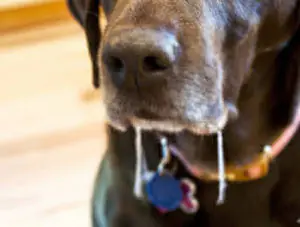Pets, like any other animals, are often susceptible to poisoning by various substances, so every caring owner should know how to rinse a dog’s stomach. Not only do curious puppies love to try everything, adults are also very curious by nature. Depending on the type of toxin that caused the poisoning, your pet's condition can worsen in a matter of hours.
The content of the articleIndications for gastric lavage
A dog can be poisoned by many substances in addition, intoxication can occur not only on the street, but also at home. Most often the animal is poisoned:
- Poisons against rats and mice. Having caught a rodent while walking, a dog almost always tries to eat its prey, as a result of which the pet’s body is poisoned by rodenticides.
- Spoiled food. Some owners like to feed their furry pets expired products, in which pathogenic bacteria are already actively multiplying.
- Medicines. Medicines intended for humans pose a mortal danger to the health of the animal.
- Household chemicals, fuels and lubricants.
When the exact source of the dog's poisoning is known, an antidote can be applied and then gastric lavage can be performed. Otherwise, the procedure for cleansing the muscle organ can greatly harm the animal.
Contraindications
Proper gastric lavage will be carried out at a veterinary clinic, but sometimes it is not possible to take your pet to a doctor. It is useful for animal owners to know how to rinse their dog’s stomach themselves, but they should remember that the procedure is contraindicated when:
- The animal is unconscious. Performing gastric lavage is dangerous, as there is a high risk of choking on vomit.
- Rat poisoning occurred. Substances used against rodents cause bleeding disorders and provoke internal bleeding. Gastric lavage will lead to even greater blood loss.
- Intoxication is caused by alkali or acid. This poisoning requires the help of a qualified specialist who will perform gastric lavage using a tube.
- The dog was poisoned by fuels and lubricants (kerosene, gasoline, diesel fuel).
Symptoms of poisoning
You can suspect that a dog has been poisoned by poisons or chemicals based on the following signs:
- the animal often vomits, there is severe weakness and lethargy
- the mouth begins to smell unpleasant

the dog completely refuses food, and sometimes even water- mucous membranes turn pale
- salivation increases
- body temperature decreases noticeably
- the animal suffers from diarrhea
- liquid feces mixed with mucus and blood
- vomit may contain bile, blood clots, and sometimes feces
- the abdominal cavity becomes painful
- weakness and cramps of the hind limbs
- there is blood coming from the eyes, nose or anus.
If you do not immediately help your pet, a comatose state will occur, and then death, so any symptoms of intoxication must be acted upon immediately.
Gastric lavage in the clinic and at home
In case of severe poisoning, you cannot risk the health of your four-legged friend only veterinary specialists will provide effective assistance to the injured dog. Using special devices, doctors will lavage the stomach, give an enema, prescribe symptomatic treatment, and select a therapeutic diet during the dog’s recovery period. But sometimes circumstances arise when it is impossible to bring the injured pet to specialists in this case, the procedure can be done at home.
How to perform gastric lavage on a dog? First, the animal must be immobilized. For large dogs, use a syringe for small dogs, a 20 cc syringe without a needle is suitable. The procedure for cleansing the stomach can be carried out using 2 methods:
- Hydrogen peroxide is mixed with an equal amount of water and poured into the pet’s mouth (no more than 15 ml of solution per 1 kg of dog’s weight). Peroxide is administered in small portions every 5 minutes. The procedure is repeated until the animal is unable to induce vomiting. As soon as the vomit takes on a transparent appearance, the victim is given sorbents.
- Warm water with soda is taken into the container (the solution should be at room temperature). The liquid is poured into the mouth in small portions until the animal begins to vomit.
Gastric lavage is not performed on a dog if the animal has been poisoned by rat poison, otherwise the dog will develop internal bleeding and die.
In order to provoke vomiting, sometimes it is enough to pour a little salt on the tongue or press on the root with your fingers. But if the animal is aggressive, the dog’s stomach is pumped by a veterinarian.
Some dog owners use it for gastric lavage, believing that this remedy will help cope with intoxication faster. The use of potassium permanganate by dogs is prohibited, as the substance can cause a burn to the stomach and esophagus, as well as intensify all existing symptoms.
Recovery
Any poisoning negatively affects the health of your four-legged friend, so after a course of therapy the animal requires special care and attention. The first day after the dog stops vomiting and diarrhea, the animal should not be fed. The only exception is clean water, which must be freely available.
On the second day, it is allowed to introduce a little food (light meat broths, boiled vegetables, viscous porridges, lean meat). After a few days, it is recommended to introduce offal, cottage cheese, boiled eggs, and fish into the diet. Food should be given in small portions, but often. During the recovery period, it is necessary to completely exclude such products as:
- pork

- pasta
- sweets
- potato
- smoked meats
- bones
- legumes
A recovering dog is prohibited from eating canned food, dry food, vegetables, fruits and raw meat.
Poisoning in pets can end in disaster, especially when the intoxication was caused by strong poisons and toxins. In most cases, it is possible to prevent serious consequences if you know how to cleanse a dog’s stomach, but provided that help is provided to the animal in a timely manner.



